On test: Ford ramps up Ranger pickup power with 281hp hybrid
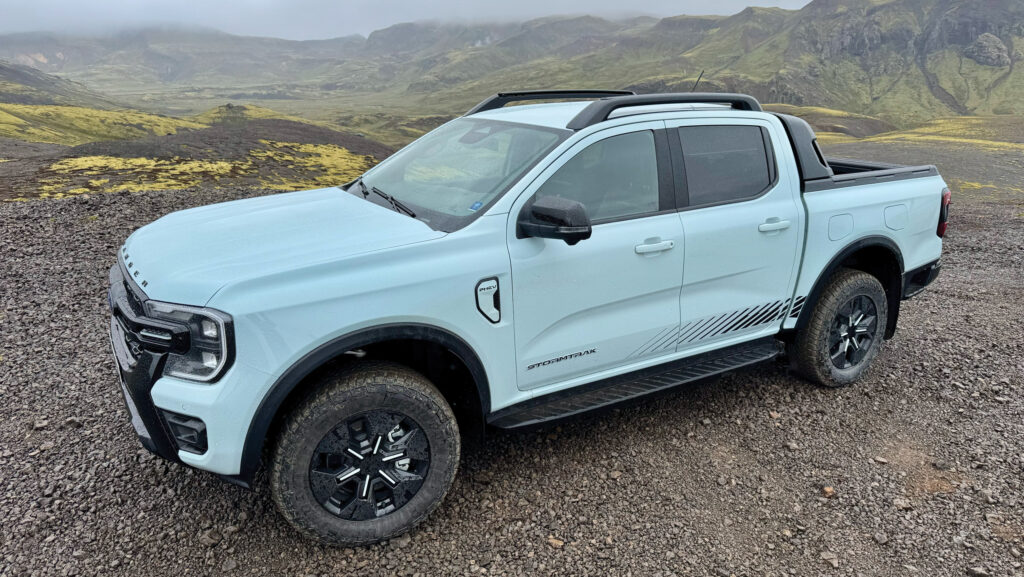 © MAG/Oliver Mark
© MAG/Oliver Mark Marrying the powers of petroleum and electrons has produced one of the pokiest Ranger pickups ever built.
Ford’s Plug-in Hybrid (Phev) powertrain – the first of its genre in Europe – pairs a 2.3-litre, four-cylinder petrol engine with a 75kW (100hp) electric motor in a thumping 281hp collaboration.
That trumps the 240hp output of the firm’s popular 3-litre, V6 diesel and, better still, the debutant delivers 679Nm of torque – the highest of any production Ranger, including the performance-tuned Raptor.
See also: On test: Electric assistance for Toyota Hilux Hybrid 48V
Though some farming customers might get twitchy about this galvanic adulteration, there are relatively few compromises.
After all, it’s built on the same platform as the 2021-launched fifth-gen Rangers, which notched a 43.6% market share in Europe last year.
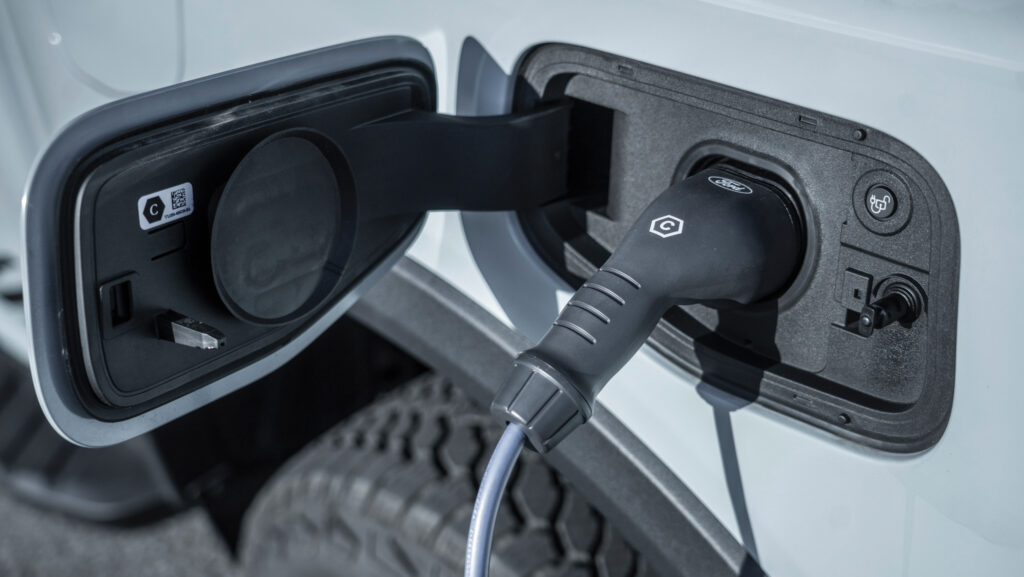
© MAG/Oliver Mark
They look almost identical – bar a plug-in port above the rear wheel arch – and it’s still rated to drag the sacrosanct 3.5t and carry a VAT-swerving 1t payload, albeit not simultaneously.
Plus, there’s the same 10-speed automatic transmission with high/low ratios and a locking rear differential, no change to the 800mm fording limit and, in theory, far lower emissions.
For company car buyers, that means more money in their pockets and less in the deep ones of the tax man.
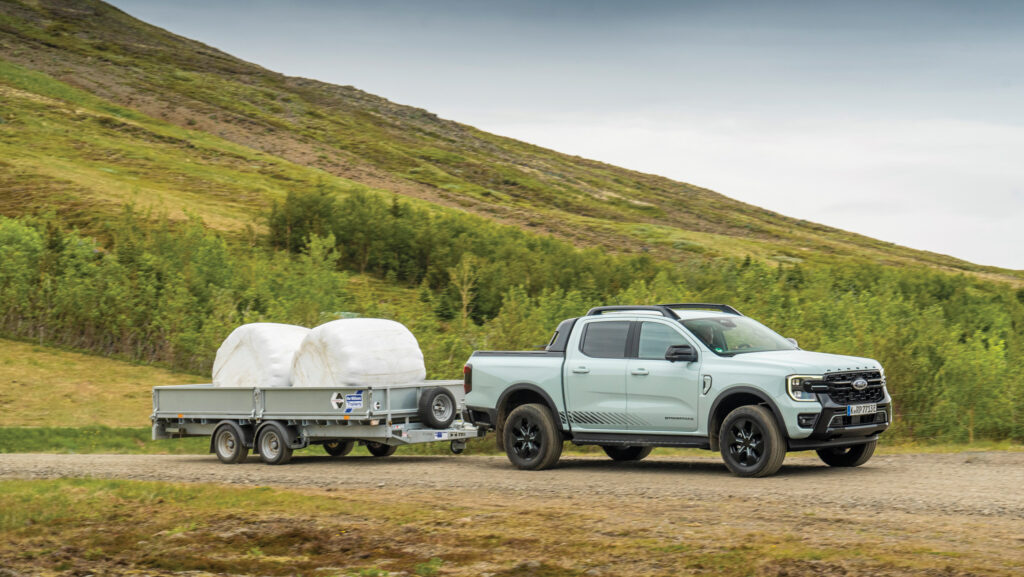
© MAG/Oliver Mark
Standard engine?
Though UK-bound Rangers are only available with a 2- or 3-litre diesel engine – the former is due to be axed from the line-up early next year – the 2.3-litre petrol has been a big seller in other markets.
For the hybrid, it has been detuned – by about 90hp – to accommodate the added oomph of the electric motor and to keep fuel economy and emissions at sensible levels.
The motor is juiced by an 11.8kWh traction battery, shaped liked a convection radiator and slung horizontally under the rear tray.
Fitting it has required some subtle fettling: extra mounting rails, suspension tweaks and, most notably, a raised load bed.
However, this 30mm hump, a “power bulge” according to Ford’s creative marketing bods, isn’t much of an issue, as the tailgate height remains as was.
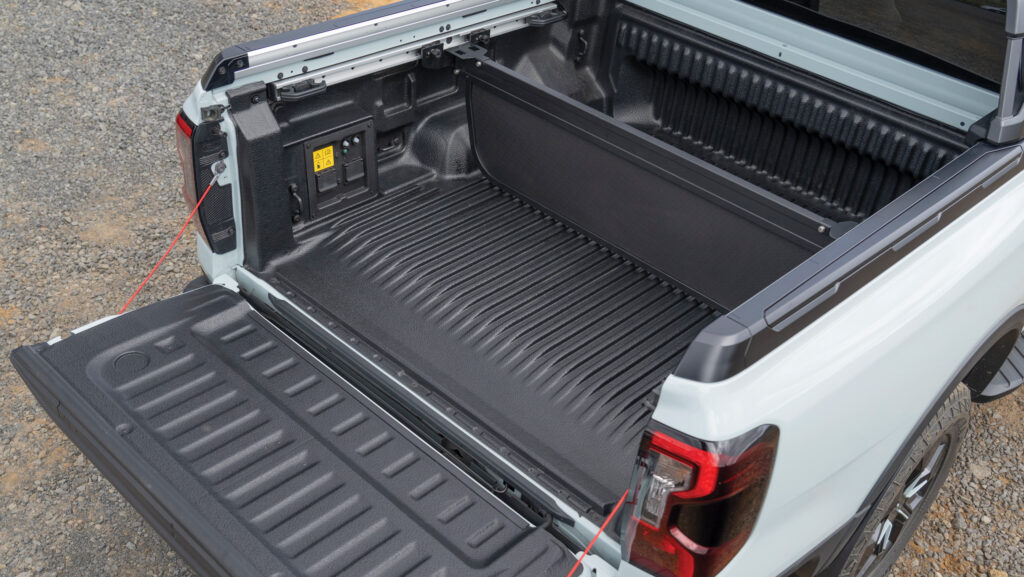
© MAG/Oliver Mark
How does it work?
The clever bit is how these two power supplies – engine at the front, e-motor in the gearbox bellhousing – are fed into the transmission, such that it behaves much like the straight diesel.
Electronically activated clutches engage and disengage one or t’other in sly and seamless fashion, based on the drive mode selected.
Drivers get several of these to play with. Most will stick with “auto EV”, which wafts between electric and internal combustion as the computer sees fit, unifying the two when necessary for peak hybrid performance.
“EV now” is pure electric, claimed to be good for a passable, if slightly underwhelming, 26 miles (empty load bed, featherweight driver).
Ford reckons that’s more than 50% of its Ranger customers (possibly not all featherweight) cover in a day, though we managed just 21 miles before the petrol kicked in for good.
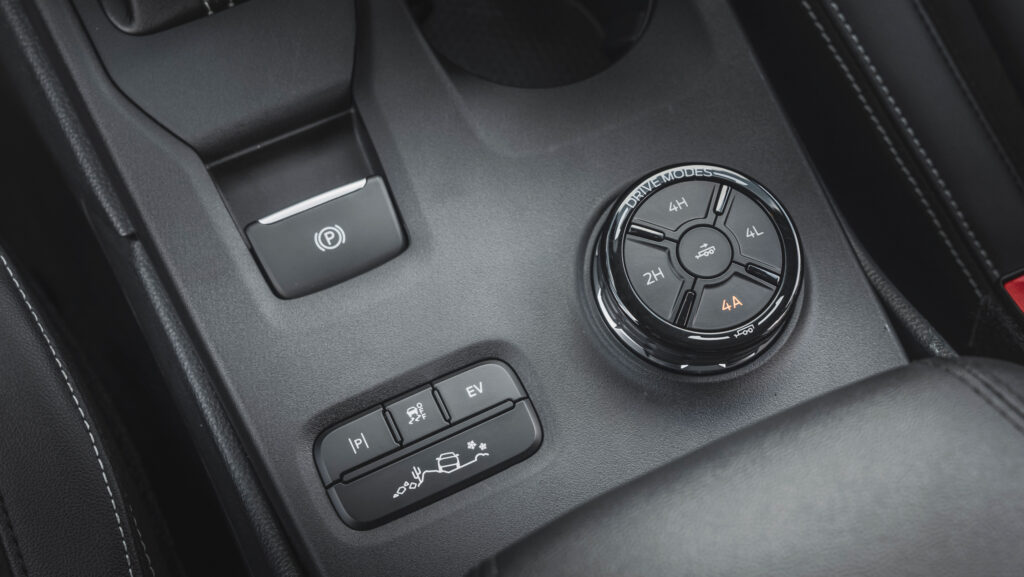
© MAG/Oliver Mark
The other modes are “EV later”, which preserves the battery power for other uses – more on this in a jiffy – and “EV charge”, whereby the engine acts as a mobile generator to replenish the cells.
It’s not an efficient way of doing so – it took more than an hour of driving to bag a seven-mile range gain, at considerable expense to fuel economy. But if you’re likely to need the Ranger’s full power and the battery level is low, it is a handy backup.
Ford Ranger Stormtrak PHEV
- Engine 2.3-litre EcoBoost four-cylinder petrol
- Motor 75kW (100hp)
- Traction battery 11.8kWh
- Power/torque 281hp@4,600rpm / 697Nm@2,500rpm
- Transmission 10-speed automatic
- 0-62mph 9.2secs
- Claimed fuel economy 95mpg
- EV-only range 26 miles
- Towing/Payload 3,500kg/1,043kg
- Payload 940kg
- Price £51,141
Beyond this, the drivetrain is identical to a diesel derivative.
How quick is it?
The instant torque of an electric motor, plus the traction benefits of a full-time four-wheel drive system, means there’s no shortage of shove – even with a weighted trailer on the tail.
And, though it reaches 62mph half a second slower than the lighter V6 diesel, it slinks fluidly through the 10 gears without fuss.
Shifts are slightly clunkier in low range, but not offensively so, and there’s the benefit of the extra retardation of a regenerative braking system that helps control descents, particularly when it’s loaded to the hilt.
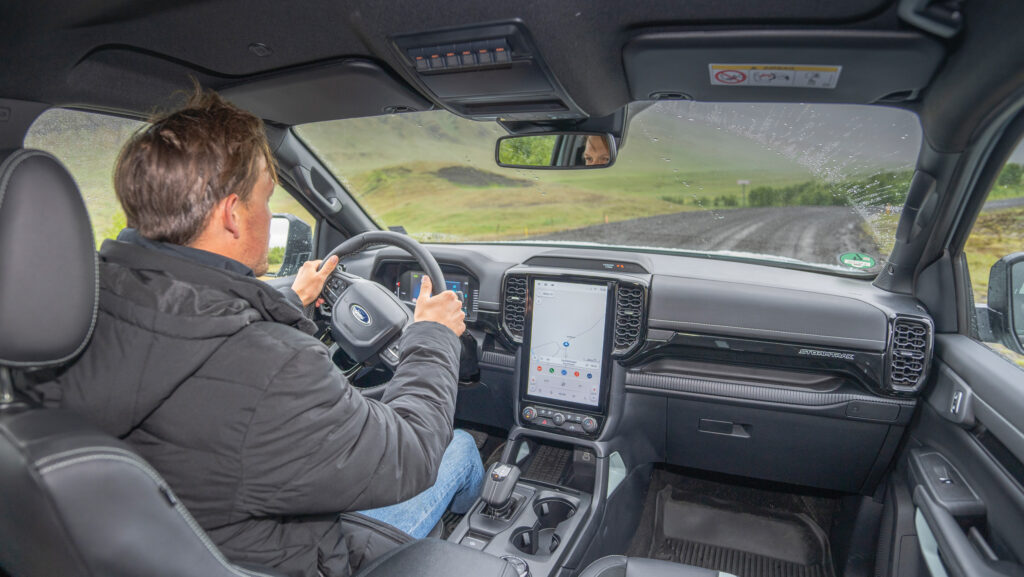
© MAG/Oliver Mark
Claimed economy is a somewhat fanciful 95mpg in hybrid mode, presumably heavily based on contributions from the quick-to-deplete battery.
Real-world figures will be governed by journey length; expect long-jaunt consumption to settle somewhere nearer the V6’s 28mpg, especially given that apex power and torque come at far higher revs.
One downside is keeping it fully fuelled, given the lack of a DC fast charging option. That means relying on the single-phase AC supply of a domestic wall box, which will take four hours from flat to full.
Fortunately, the petrol tank is at least a sensible size – 70 litres, 10 less than the diesel.
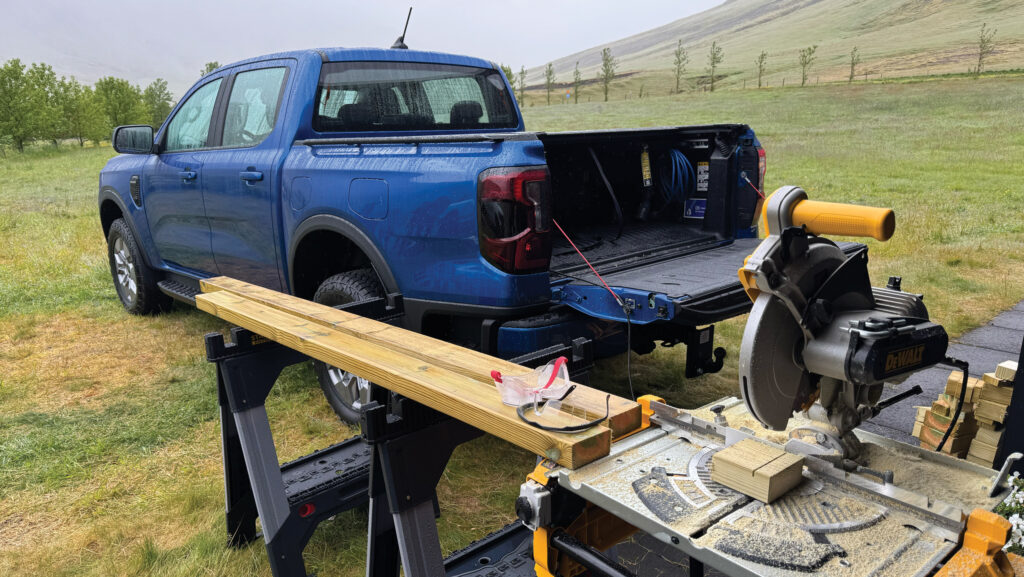
© MAG/Oliver Mark
Any new features?
Two stand-out items here, the first of which is Pro Power Onboard.
Launched on the eTransit in the UK and F-series pickup in the US, it uses the 11.8kWh battery to power a socket in the cab and a brace in the load bed.
There are two versions available, starting with a 2.3kW setup that should be enough to run a worker’s circular saw or gang battery charger, or a camper’s toaster or hair dryer. It is standard on the flagship Stormtrak model, and a £1,200 option on the Wildtrak.
Alternatively, there’s a 6.9kW upgrade (£1,750), which puts out 2.3kW in the cabin and 3.45kW – angle grinder territory – from each of the 15A sockets in the back.
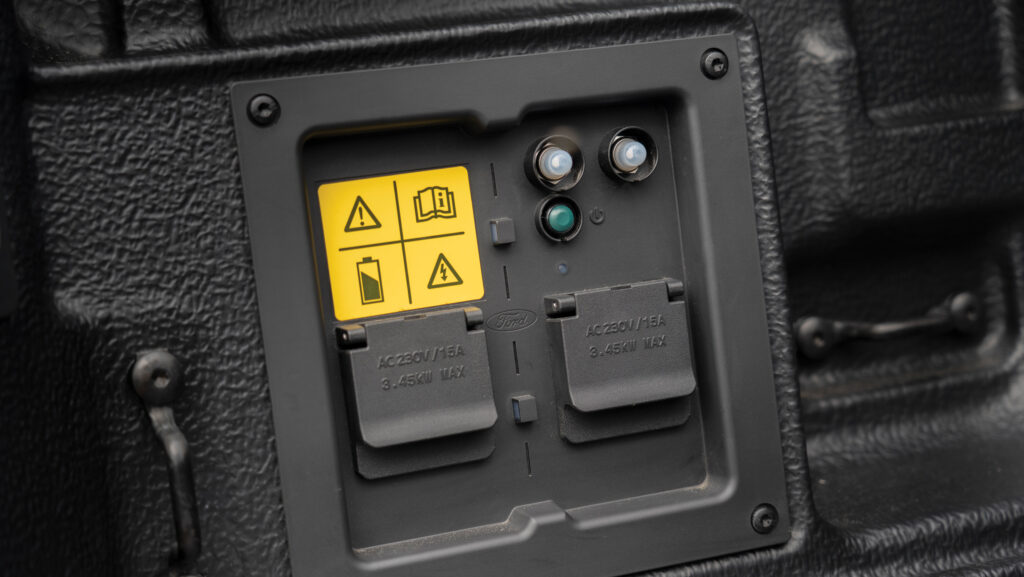
© MAG/Oliver Mark
The other novelty is the suite of towing-related technology that makes it easier to connect and reverse a trailer without embarrassment.
This starts with twin rear cameras – one facing backwards, the other directly above the coupling – to align ball and cup with near-millimetre precision.
Then there’s the “pro trailer backup assist” system, which requires the trailer’s vital stats – total length, drawbar length, width, wheel position, etc – to be tapped into the 12in touchscreen or recalled from a saved list.
After a quick calibration, the trailer can be “steered” using the 4wd dial on the centre console, with semi-artificial intelligence turning the truck’s wheel accordingly.
Sounds gimmicky, but it makes jack-knifing impossible and also alters the blind spot recognition system to account for the trailer.
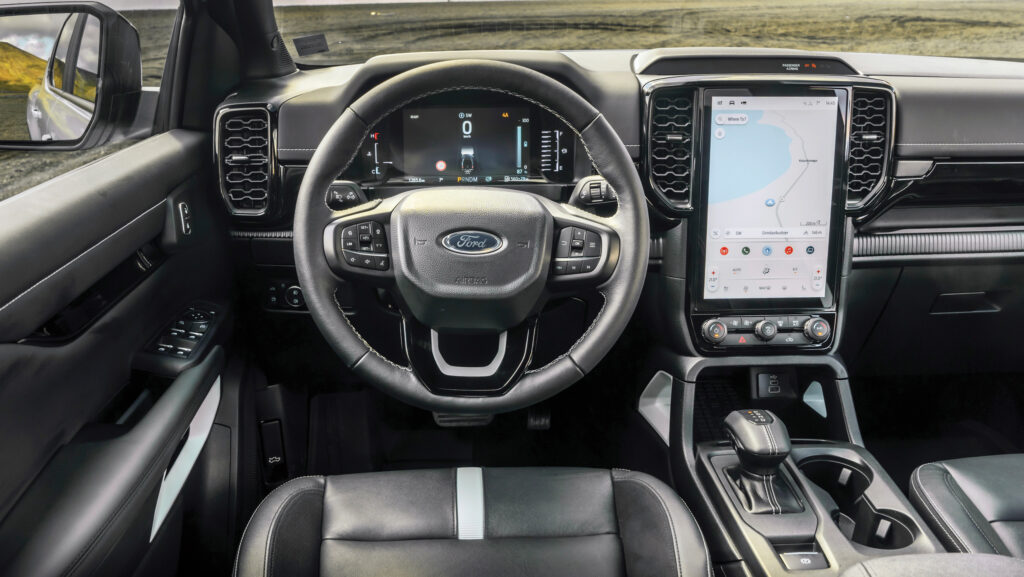
© MAG/Oliver Mark
What’s the interior like?
It’s as-you-were inside, and impressively quiet thanks to the combination of hybrid drive and headphones-style noise cancellation that eliminates the majority of din.
Expect near-SUV grade comfort, an easy-to-navigate vertical touchscreen and, mercifully, some nobbly dials for the climate control and sound system.
Minor issues are slightly undersized door pockets and cupholders, and an overly sensitive driver fatigue warning system that didn’t take kindly to this writer’s presumably slothful driving style.
Which models?
The cheapest hybrid Ranger is the workaday XLT (£40,841), followed by the mid-range Wildtrak (£46,241).
The extra bunce adds stylish things, heat to the front seats and steering wheel, 360deg exterior lighting and adaptive cruise.
Then there’s the flagship Stormtrak (£51,141), which gains a 10-speaker B&O sound system, 2.3kW Pro Power Onboard and racking in the bed.
For comparison, a 2-litre, 205hp Wildtrak diesel starts at £41,691, and the 3-litre, 240hp version at £47,241.
Farmers Weekly verdict
As greener pickup options go, the plug-in hybrid Ranger treads a safe track between electrification and practicality, particularly compared with the undesirable concessions that riddle the all-electric Maxus T90 and, probably, the yet-to-sell Isuzu D-Max EV.
Plus, price premiums over the diesels are modest given the potential financial savings, they’ll tow and carry as much, and they’re more powerful.
However, these rewards will only be realised if charging is taken seriously, so it’s a shame the battery is so small and takes so long to replenish.
The big winners will be those running a double-cab pickup as a company car.
Though benefit-in-kind rates, now based on carbon dioxide emissions, are significantly higher than the pre-April flat rate, the Phev’s modest 71g/km puts it well below the top-bracket diesel Wildtraks.
That will mean a difference in tax liabilities of up to £4,000 a year for a 40% taxpayer.
Model choice purely comes down to spec; the XLT looks perfectly well sorted, though it would be folly not to fork out the extra £1,750 for Pro Power Onboard.
And, if you buy one, remember to grab the green pump at the petrol station.
Likes and gripes
Likes
- Powerful
- Refined 2.3-litre engine
- Load bed sockets to power tools
- Nifty trailer control system
Gripes
- No DC fast charging
- Modest electric-only range
- Max power relies on regular charging
- Can’t max out payload and towing capacity simultaneously

